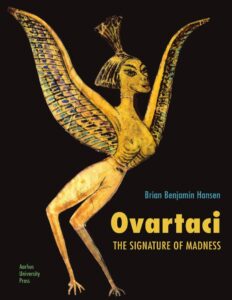Exclusive lecture by philosopher Brian Benjamin Hansen
This lecture is in English
Time: 15:00 – 15:45, followed by questions from the audience.
Price: free (excluding museum admission)
Booking: reserve your ticket for the lecture on Sunday 30 April here. You need a museum ticket for attending the lecture, this you can buy on the spot at the register or online by selecting a time slot.
On Sunday 30 April, the Cobra Museum is organising a special lecture by Brain Benjamin Hansen. Hansen is a philosopher and author of the book Ovartaci: The Signature of Madness and in this lecture will zoom in on the theme to which the title of this exhibition Becoming Ovartaci refers: the process of becoming Ovartaci.

Becoming Ovartaci
Ovartaci changed himself throughout his life, from a shy boy from rural Denmark, named Louis Marcussen, to the great artist Ovartaci, the creator of spectacular visions from a life in other eras and places. He morphed from a shy boy into a shaman, who stood in contact with spirits, animal spirits, and the spirits of long-lost family, which he magically brought to life with improvised materials.
Brian Benjamin Hansen argues that to understand Ovartaci’s work it is not only necessary to describe the life with all its biographical details, but also this artist’s persistent self-experimental productivity:
“Ovartaci cannot accept to have been born as Louis Marcussen, and he cannot accept the body he was put into. To become Ovartaci is to fight Louis, and it is also to fight great forces in himself, not least the force of sexuality. In my lecture, I will outline the way Ovartaci fights himself and the way he manages to restructure through new religious and aesthetic texture. Ovartaci’s art is not, I argue, raw “art brut”, but on the contrary a very refined attempt to rebuild a world out of joint.”
The Signature of Madness
In his book, Ovartaci: The Signature of Madness, Hansen has outlined two aesthetic strategies at play in Ovartaci’s work, namely the strategies of “cutting” and “adding”. The strategy of cutting has to do with a sometimes very violent fight against the harmful forces attacking Ovartaci; this fight is also fought on the turf of his own body. Ovartaci wants to eliminate, or cut out, the evil forces in himself. The strategy of cutting is a destructive strategy, which says something about the high stakes of the art of Ovartaci. Even if it makes a colorful, if somewhat spooky and ambiguous first impression, it is not without trauma.
The strategy of adding has to do with how something that is not functioning is replaced by something new. For example, the male body is replaced by a female body. But this strategy of adding works not only at the affective level of bodily feeling and intensity, but also at the level of social inscription. Hence the name “Ovartaci”,which replaces the name Louis Marcussen, itself carries enormous weight. It can be used as an escape to another life or as a magical tool, but it also has its own mythology and genealogy, with its many strange bodies, figures, animals and landscapes and with its background anecdotes about life in other reincarnations, often told by Ovartaci. Delusion is not madness, as Freud already knew, but “in reality an attempt at recovery, a process of reconstruction.”
The book will be available at the Cobra Museum’s museum shop.

Brian Benjamin Hansen
Brian Benjamin Hansen is a philosopher. He is a postdoctoral researcher at Aarhus University and senior associate professor at VIA University College. Latest publications are Ovartaci: The Signature of Madness (Aarhus University Press, 2022) and Analysing the Cultural Unconscious (editor) (Bloomsbury, 2020).
* Questions about ticket sales? From Monday to Friday, call 020 547 50 37 between 9am and 5pm.
